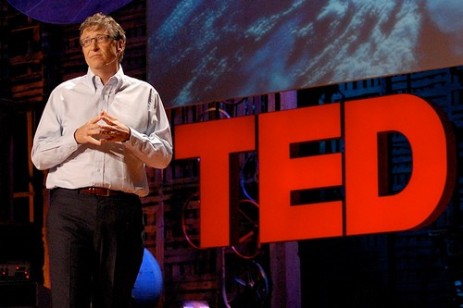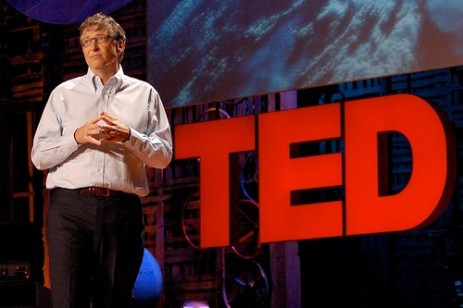 Bill Gates is sad that David Roberts thinks he’s wrong.Photo: redmaxwell via FlickrBill Gates, the Microsoft founder and philanthropist, made waves last week when, at the much-celebrated tech conference TED, he proclaimed that climate change is the most important problem facing the planet. Wo0t! Obviously having someone of Gates’ stature supporting the clean energy race is an unqualified good. (See Alex Steffen on Gates’ talk.)
Bill Gates is sad that David Roberts thinks he’s wrong.Photo: redmaxwell via FlickrBill Gates, the Microsoft founder and philanthropist, made waves last week when, at the much-celebrated tech conference TED, he proclaimed that climate change is the most important problem facing the planet. Wo0t! Obviously having someone of Gates’ stature supporting the clean energy race is an unqualified good. (See Alex Steffen on Gates’ talk.)
That said, Gates has burst on to the energy scene with some rather ill-considered thinking. To get a flavor, see his blog post, “Why We Need Innovation, Not Just Insulation.” The idea is that “conservation and behavior change” might get the world to its 2020 or 2030 targets, but to get to 80 percent emissions reductions by 2050 we’ll need fundamental technological innovation. Ergo: we should pay more attention to, and devote more money to, basic science and R&D.
Now: it’s incontestably true that the U.S. investment in R&D is lower than it should be. We should increase funding in the search for game-changing technology that can help us generate and use energy more sustainably. Indeed, we should increase funding in lots of things! Therein lies the rub.
There are two problems with Gates’ dichotomy between innovation and insulation. The first is the more obvious but the second is more meaningful. (Also, see Joe Romm and Sean Casten for further Gates critiques.)
1. Insofar as there’s a distinction between developing new technology that helps generate more/cleaner/cheaper energy and using energy more wisely, we obviously need to do both. Just as efficiency alone will never get us to our goals, neither will new generation. Richard Heinberg at the Post-Carbon Institute argues, in his report “Searching for a Miracle,” that …
… there is little likelihood that either conventional fossil fuels or alternative energy sources can reliably be counted on to provide the amount and quality of energy that will be needed to sustain economic growth — or even current levels of economic activity — during the remainder of the current century.
I don’t know if Heinberg’s right. I’m inclined to think there’s greater potential in renewable energy than he allows, but I’m too keenly aware of my cognitive shortcomings to get into the Math’n’Graph Olympics. Either way, it’s a safe bet that whatever breakthroughs in energy generation technology arrive in coming decades, they won’t be able, in and of themselves, to keep up with rising population and affluence. And it would be sheerest folly to depend on their arrival.
Getting maximum energy services out of each electron will be an overriding human imperative in the 21st century, and it will require every bit as much ingenuity and imagination as the pursuit of new generation technology. It’s not a zero sum game; there is no reasonable sense in which concern for efficiency is eclipsing concern for innovation. We absolutely have to do both, and no country on earth is doing either at the scale that will ultimately be required.
2. Innovation ≠ technology.
The deeper and more pernicious problem with Gates’ framing is the implication that technology is where we innovate; in all other areas of life, we just … manage. This taps into some deep archetypes that are worth digging up.
In modern industrial society we’ve come to see progress as effectively synonymous with technology. When it comes to energy, when someone says “invest in new technology or,” the or is usually followed some version of restricting, curtailing, or sacrificing. Technology is the opposite of constraint. Proponents of the technology-centric policy perspective cast themselves as forward-looking optimists — in contrast, implicitly or explicitly, to the dour doom-and-gloomers who want you to shiver in the dark. They find easy favor because in America optimism is technology, and vice versa.
I’ve come to think that this conflation of progress/innovation and technology — specifically energy-generation technology — is one of the principal barriers to a bright green future. To illustrate the point, consider a book I recently reviewed, Reinventing the Automobile, by two engineers from from GM’s advanced auto division and the head of MIT’s Smart Cities program. Among other things, it describes the sustainable city of the future in considerable detail. Here is an extremely condensed sketch of that city:
Everything is linked up in a smart, integrated communications, power, and transportation network. The city “knows” which roads are congested and which parking spots are free. It can communicate to individuals what combination of walking, transit, and individual vehicles will get them where they’re going fastest. Vehicles are small, electric, modular, and — via sensors, GPS, and broadband wireless — intelligent, so they can pilot and park themselves. They can be charged by parking-integrated stations or even electromagnetic coils embedded in curbs, and since they’re interchangeable and easily customizable, they can be public goods (like today’s car-sharing services), easily swapped out and thus continuously in use. The city uses the vehicles’ batteries as distributed energy storage, along with other storage options including pumped hydro integrated into the sewer system. Rooftops, parking lots, and other marginal lands are covered with solar panels; small-scale wind turbines are perched on bridges and towers; cogeneration systems are attached to every industrial facility. Through smart design and sensing, every building and neighborhood maximizes efficiency. The city senses power demand, knows where power is being produced and stored, and continuously balances supply and demand.
Cool, right?! At first blush it sounds like a Jetsons techno-fantasy. Here’s the thing, though: according to the authors, who should know, most of the necessary technology either exists or is in development. None of it relies on any major breakthroughs. By a wide margin, the biggest barriers to creating such bright green cities are social. To pick just a handful:
- Building a city that behaves like an integrated organism means developing a holistic, long-term plan that will coordinate multiple agencies and levels of government. Big, long-term thinking is not exactly an American strong suit these days. Also — and this is a underappreciated problem — cities are cripplingly dependent on the financial largesse of state and federal authorities. They have very little autonomy to borrow money and invest in their own futures.
- There are all kinds of collective action and first-mover problems: Who puts the charging stations in if there aren’t electric cars on the road yet, and vice versa? Who pays for a smart grid before distributed generation is in place, and vice versa? How can public infrastructure and private market development be coordinated?
- Many of the investments involve high upfront costs that are paid back slowly over time. New financing models will be needed both for private individuals and companies and for cities themselves.
- Changes in the way individuals live, work, communicate, and travel must be introduced in a way that maintains social cohesion and political support for further changes. That requires research in social psychology and other behavioral disciplines (sorely lacking in much policymaking). How these things are introduced matters just as much as what they are.
One could go on. The point is that the way we live together now, the way we govern ourselves, the way we arrange our physical spaces and our commerce, the way we do economics and measure prosperity — all these have to be changed in creative ways if we want to achieve the goal of sustainable prosperity. All these changes require … wait for it … innovation. Innovations in the way we think, interact, and structure our lives require just as much imagination, intelligence, persistence, and funding as innovations in technology.
Consider this analogy: The best brain research and social science show that reason, emotion, instinct, and social context are all part of a seamless whole, human being. There is no separate faculty called “reason” that operates outside or above. The division between “reason and emotion” is spurious — there is no one without the other; they are part of the same process.
Similarly, technology is not a separate thing unto itself. Tools, like customs, laws, built spaces, and ecological processes, are part of a seamless whole of human society. Technology happens in a social context, is of a social context; it shapes and is shaped by the context. Innovating new tools is not an alternative to innovating new social arrangements, much less a substitute; it is part and parcel of the same process.
Bill Gates is right that we need more funding, support, and attention applied to energy technology. But if we truly seek to fashion a sustainable future, we need just as much applied to laws, regulations, infrastructure, economics, behaviors, and values. We need to innovate a new way of being in the world, not just new tools.


